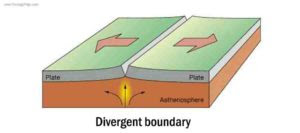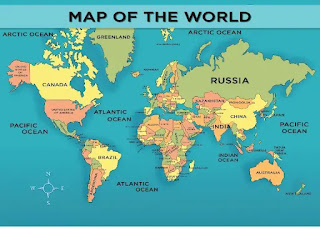Activity 14 l Types of Plates Boundaries
Three Types of Plates Tectonics
PHOEBE MARIE BOHOL 10-DILIGENCE
Earthquakes, volcanic activity, mountain-building and oceanic trench formation occur along plate boundaries in zones that may be anything from a few kilometers to a few hundred kilometers. In the theory of plate tectonics, a boundary between two or more plates. The plates can be moving toward each other (at convergent plate boundaries), away from each other (at divergent plate boundaries), or past each other (at transform faults).
A. DIVERGENT PLATE BOUNDARIES
Divergent boundaries, sometimes called constructive boundaries, lithospheric plates move away from each other. There are two types of divergent boundaries, categorized by where they occur: continental rift zones and mid-ocean ridges. Continental rift zones occur in weak spots in the continental lithospheric plate. A mid-ocean ridge usually originates in a continental plate as a rift zone that expands to the point of splitting the plate apart, with seawater filling in the gap. The separate pieces continue to drift apart and become individual continents.
B.CONVERGENT PLATE BOUNDARIES
Where plates crash together, one dives (“subducts”) beneath the other, causing volcanoes (red triangles) to erupt on the overriding plate and earthquakes (black stars) at a variety of depths. The large white star represents the zone where plates lock together for centuries then suddenly let go, causing the largest earthquakes.
Three of Convergent Plate Boundaries
Convergent Plate Boundary - Oceanic
When a convergent boundary occurs between two oceanic plates, one of those plates will subduct beneath the other. Normally the older plate will subduct because of its higher density. The subducting plate is heated as it is forced deeper into the mantle, and at a depth of about 100 miles (150 km) the plate begins to melt. Magma chambers are produced as a result of this melting, and the magma is lower in density than the surrounding rock material. It begins ascending by melting and fracturing its way through the overlying rock material. Magma chambers that reach the surface break through to form a volcanic eruption cone. In the early stages of this type of boundary, the cones will be deep beneath the ocean surface but later grow to be higher than sea level. This produces an island chain. With continued development the islands grow larger, merge, and an elongate landmass is created.
Convergent Plate Boundary - Oceanic and Continental Plates
When continental and oceanic plates collide, the thinner and more dense oceanic plate is overridden by the thicker and less dense continental plate. The oceanic plate is forced down into the mantle in a process known as "subduction." As the oceanic plate descends, it is forced into higher temperature environments. At a depth of about 100 miles (160 km), materials in the subducting plate begin to approach their melting temperatures and a process of partial melting begins.
Convergent Plate Boundary - Continental
This is a difficult boundary to draw. First it is complex and second, it is poorly understood when compared to the other types of plate boundaries. In this type of convergent boundary, a powerful collision occurs. The two thick continental plates collide, and both of them have a density that is much lower than the mantle, which prevents subduction (there may be a small amount of subduction, or the heavier lithosphere below the continental crust might break free from the crust and subduct).
C. TRANSFORM PLATE BOUNDARIES
Two plater sliding past each other forms a transform boundary. One of the most famous transform plate boundaries occurs at the San Andreas fault zone, which extends underwater. Natural or human-made structures that cross a transform boundary are offset—split into pieces and carried in opposite directions. Rocks that line the boundary are pulverized as the plates grind along, creating a linear fault valley or undersea canyon. Earthquakes are common along these faults. In contrast to convergent and divergent boundaries, crust is cracked and broken at transform margins, but is not created or destroyed.








Comments
Post a Comment